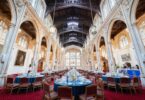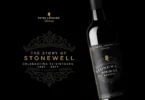Bordeaux Odessa
Posted: 3rd April 2017
A month without travel, and a month without glory; but there were a few consolations. I had some nice Belgian ales from Petrus that boasted their degrees of sourness on the label. Petrus is made by De Brabandere brewery in Bavikhove, somewhere between Ghent and Dunkirk, and aged in huge oak tuns. I liked the Aged Pale best, which was the most uncompromisingly and refreshingly sour, but both the Oud Bruin (Old Brown) and the cherry-flavoured Red were delicious. The two-year old Pale also acts as the mother to the others. In Oud Bruin, the Pale is mixed with a younger brown ale while the Red has the attraction of cherries – like a Kriek, but not fermented spontaneously, like a Kriek, if you know what I mean. All these beers are available from alesbymail.co.uk.
While we are on the subject of barley brews, I also had a nice new malt: Bacalta from Glenmorangie. I have a little reservation about modern malts, which seem to be all about bling-bling and not really the taste of the product as it comes off the still, but rather more the way you tart it up. Of course, to some extent this was always so – the whisky tasted different from a sherry butt, a new-from-Kentucky ex-bourbon ‘hoggie’, or a second use cask; but each distillery had its own style, and that style was represented by one or two or three ‘expressions’ that defined the malt whisky, and was generally identifiable by an ‘age statement’ (10, 15, 20-years old etc). Now there are bedevilling numbers of different malts with fantasy names from even quite indifferent distilleries, some of which, until very few years ago, you would have crossed the glen to avoid.
I would never have said that about Glenmorangie, mind you, which I always liked, even if it always struck me as unusual as a hard-water whisky. Bacalta is pale, and bottled at a respectable 46 percent. I presume second-use Bourbon casks were used to give it that vanilla flavour, although they seem to have been softened up with some Madeira which might have imparted a small, lemony taste. On the palate Bacalta reminded me of a nice creamy panna cotta, with walnuts.
On 23 March I headed west to a dinner at the Design Museum in Kensington. This was on the site of the old Commonwealth Institute which I used to haunt as a free-range child. There were little niches then, featuring the typical products of places like Southern Rhodesia and Bechuanaland – shields and drums and assegais – and a curious odour of stale buns and stewed tea. With time I graduated to the Science Museum in South Ken, and then with the onset of puberty, to the cast galleries in the Victoria & Albert. I expected the old building – a handkerchief dropped onto a box – to have been knocked down, but no – it was still there and far more fragrant inside than it was when I was a nipper.
The evening celebrated the work of Olivier Dauga, ‘le faiseur du vin’ (‘The Winemaker’) who is active in Bordeaux and the Ukraine and has made the wines at Châteaux Sociando Mallet, La Tour Carnet and many others. Dauga was formerly of the ‘garage’ school of winemakers who grew up around Jean-Luc Thunevin in the 1990s. Thunevin took the wine-world by storm with his obscure Château Valandraud which came out at the same price as the first growths. Thunevin’s success inspired many others who then selected and polished their grapes as he did, and aged the wine in not one but two new oak casks.







